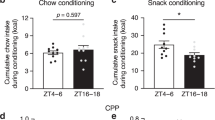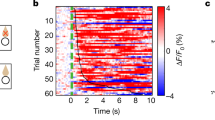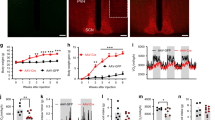Abstract
Background:
Rats that have restricted access to food at a fixed time point of the circadian phase display high levels of food anticipatory activity (FAA). The orexigenic hormone ghrelin has been implicated in the regulation of FAA. However, it is not known via which brain area ghrelin exerts this effect. Growth hormone secretagogue receptor 1a (GHS-R1a) is highly expressed in the hypothalamus, including the dorsomedial hypothalamus (DMH) and the ventromedial hypothalamus (VMH). These two hypothalamic areas have been reported to play a role in FAA.
Aim of the study:
To examine the role of GHS-R1a signaling in the DMH and VMH in FAA.
Design:
Adeno-associated virus expressing a shRNA directed against GHS-R1a was used to establish local knockdown of GHS-R1a in the DMH and VMH in rats. Rats were subsequently subjected to a restricted feeding schedule (RFS).
Results:
Under ad libitum conditions, knockdown of GHS-R1a in the VMH increased food intake and body weight gain. In addition, GHS-R1a knockdown in VMH and DMH reduced body temperature and running wheel activity (RWA). When rats were subjected to a RFS, the main effect of GHS-R1a knockdown in both DMH and VMH was a decrease in RWA and an attenuation of body weight loss. Rats with knockdown of GHS-R1a in DMH and VMH showed a delay in onset of FAA. In addition, GHS-R1a knockdown in DMH resulted in a reduction of FAA amplitude.
Conclusion:
This is the first study to investigate the effect of local hypothalamic knockdown of GHS-R1a on FAA. Our results implicate hypothalamic GHS-R1a signaling in the regulation of FAA. Nevertheless, some FAA remained, suggesting that a distributed network of brain areas and signaling pathways is involved in the development of FAA.
This is a preview of subscription content, access via your institution
Access options
Subscribe to this journal
Receive 12 print issues and online access
$259.00 per year
only $21.58 per issue
Buy this article
- Purchase on Springer Link
- Instant access to full article PDF
Prices may be subject to local taxes which are calculated during checkout





Similar content being viewed by others
References
Kojima M, Hosoda H, Date Y, Nakazato M, Matsuo H, Kangawa K . Ghrelin is a growth-hormone-releasing acylated peptide from stomach. Nature 1999; 402: 656–660.
Tschop M, Smiley DL, Heiman ML . Ghrelin induces adiposity in rodents. Nature 2000; 407: 908–913.
Wren AM, Small CJ, Ward HL, Murphy KG, Dakin CL, Taheri S et al. The novel hypothalamic peptide ghrelin stimulates food intake and growth hormone secretion. Endocrinology 2000; 141: 4325–4328.
Nakazato M, Murakami N, Date Y, Kojima M, Matsuo H, Kangawa K et al. A role for ghrelin in the central regulation of feeding. Nature 2001; 409: 194–198.
Shiiya T, Nakazato M, Mizuta M, Date Y, Mondal MS, Tanaka M et al. Plasma ghrelin levels in lean and obese humans and the effect of glucose on ghrelin secretion. J Clin Endocrinol Metab 2002; 87: 240–244.
Kamegai J, Tamura H, Shimizu T, Ishii S, Sugihara H, Wakabayashi I . Chronic central infusion of ghrelin increases hypothalamic neuropeptide Y and Agouti-related protein mRNA levels and body weight in rats. Diabetes 2001; 50: 2438–2443.
Guan XM, Yu H, Palyha OC, McKee KK, Feighner SD, Sirinathsinghji DJ et al. Distribution of mRNA encoding the growth hormone secretagogue receptor in brain and peripheral tissues. Brain Res Mol Brain Res 1997; 48: 23–29.
Zigman JM, Jones JE, Lee CE, Saper CB, Elmquist JK . Expression of ghrelin receptor mRNA in the rat and the mouse brain. J Comp Neurol 2006; 494: 528–548.
Mistlberger RE . Circadian food-anticipatory activity: formal models and physiological mechanisms. Neurosci Biobehav Rev 1994; 18: 171–195.
Escobar C, Salgado R, Rodriguez K, Blancas Vazquez AS, Angeles-Castellanos M, Buijs RM . Scheduled meals and scheduled palatable snacks synchronize circadian rhythms: Consequences for ingestive behavior. Physiol Behav 2011; 104: 555–561.
Cummings DE, Purnell JQ, Frayo RS, Schmidova K, Wisse BE, Weigle DS . A preprandial rise in plasma ghrelin levels suggests a role in meal initiation in humans. Diabetes 2001; 50: 1714–1719.
Drazen DL, Vahl TP, D'Alessio DA, Seeley RJ, Woods SC . Effects of a fixed meal pattern on ghrelin secretion: evidence for a learned response independent of nutrient status. Endocrinology 2006; 147: 23–30.
LeSauter J, Hoque N, Weintraub M, Pfaff DW, Silver R . Stomach ghrelin-secreting cells as food-entrainable circadian clocks. Proc Natl Acad Sci USA 2009; 106: 13582–13587.
Verhagen LA, Egecioglu E, Luijendijk MC, Hillebrand JJ, Adan RA, Dickson SL . Acute and chronic suppression of the central ghrelin signaling system reveals a role in food anticipatory activity. Eur Neuropsychopharmacol 2011; 21: 384–392.
Blum ID, Patterson Z, Khazall R, Lamont EW, Sleeman MW, Horvath TL et al. Reduced anticipatory locomotor responses to scheduled meals in ghrelin receptor deficient mice. Neuroscience 2009; 164: 351–359.
Davis JF, Choi DL, Clegg DJ, Benoit SC . Signaling through the ghrelin receptor modulates hippocampal function and meal anticipation in mice. Physiol Behav 2011; 103: 39–43.
Angeles-Castellanos M, Aguilar-Roblero R, Escobar C . c-Fos expression in hypothalamic nuclei of food-entrained rats. Am J Physiol Regul Integr Comp Physiol 2004; 286: R158–R165.
Johnstone LE, Fong TM, Leng G . Neuronal activation in the hypothalamus and brainstem during feeding in rats. Cell Metab 2006; 4: 313–321.
Poulin AM, Timofeeva E . The dynamics of neuronal activation during food anticipation and feeding in the brain of food-entrained rats. Brain Res 2008; 1227: 128–141.
Davidson AJ . Lesion studies targeting food-anticipatory activity. Eur J Neurosci 2009; 30: 1658–1664.
Ribeiro AC, Sawa E, Carren-LeSauter I, LeSauter J, Silver R, Pfaff DW . Two forces for arousal: Pitting hunger versus circadian influences and identifying neurons responsible for changes in behavioral arousal. Proc Natl Acad Sci USA 2007; 104: 20078–20083.
Choi S, Wong LS, Yamat C, Dallman MF . Hypothalamic ventromedial nuclei amplify circadian rhythms: do they contain a food-entrained endogenous oscillator? J Neurosci 1998; 18: 3843–3852.
Gooley JJ, Schomer A, Saper CB . The dorsomedial hypothalamic nucleus is critical for the expression of food-entrainable circadian rhythms. Nat Neurosci 2006; 9: 398–407.
Mieda M, Williams SC, Richardson JA, Tanaka K, Yanagisawa M . The dorsomedial hypothalamic nucleus as a putative food-entrainable circadian pacemaker. Proc Natl Acad Sci USA 2006; 103: 12150–12155.
Angeles-Castellanos M, Salgado-Delgado R, Rodriguez K, Buijs RM, Escobar C . Expectancy for food or expectancy for chocolate reveals timing systems for metabolism and reward. Neuroscience 2008; 155: 297–307.
Minana-Solis MC, Angeles-Castellanos M, Feillet C, Pevet P, Challet E, Escobar C . Differential effects of a restricted feeding schedule on clock-gene expression in the hypothalamus of the rat. Chronobiol Int 2009; 26: 808–820.
Moriya T, Aida R, Kudo T, Akiyama M, Doi M, Hayasaka N et al. The dorsomedial hypothalamic nucleus is not necessary for food-anticipatory circadian rhythms of behavior, temperature or clock gene expression in mice. Eur J Neurosci 2009; 29: 1447–1460.
Landry GJ, Simon MM, Webb IC, Mistlberger RE . Persistence of a behavioral food-anticipatory circadian rhythm following dorsomedial hypothalamic ablation in rats. Am J Physiol Regul Integr Comp Physiol 2006; 290: R1527–R1534.
Landry GJ, Yamakawa GR, Webb IC, Mear RJ, Mistlberger RE . The dorsomedial hypothalamic nucleus is not necessary for the expression of circadian food-anticipatory activity in rats. J Biol Rhythms 2007; 22: 467–478.
Acosta-Galvan G, Yi CX, van der Vliet J, Jhamandas JH, Panula P, Angeles-Castellanos M et al. Interaction between hypothalamic dorsomedial nucleus and the suprachiasmatic nucleus determines intensity of food anticipatory behavior. Proc Natl Acad Sci USA 2011; 108: 5813–5818.
Krieger DT . Ventromedial hypothalamic lesions abolish food-shifted circadian adrenal and temperature rhythmicity. Endocrinology 1980; 106: 649–654.
Inouye ST . Ventromedial hypothalamic lesions eliminate anticipatory activities of restricted daily feeding schedules in the rat. Brain Res 1982; 250: 183–187.
Mistlberger RE, Rechtschaffen A . Recovery of anticipatory activity to restricted feeding in rats with ventromedial hypothalamic lesions. Physiol Behav 1984; 33: 227–235.
Honma S, Honma K, Nagasaka T, Hiroshige T . The ventromedial hypothalamic nucleus is not essential for the prefeeding corticosterone peak in rats under restricted daily feeding. Physiol Behav 1987; 39: 211–215.
Hommel JD, Trinko R, Sears RM, Georgescu D, Liu ZW, Gao XB et al. Leptin receptor signaling in midbrain dopamine neurons regulates feeding. Neuron 2006; 51: 801–810.
Gunapala KM, Gallardo CM, Hsu CT, Steele AD . Single gene deletions of orexin, leptin, neuropeptide Y, and ghrelin do not appreciably alter food anticipatory activity in mice. PLoS One 2011; 6: e18377.
de Backer MW, Brans MA, van Rozen AJ, van der Zwaal EM, Luijendijk MC, Garner KG et al. Suppressor of cytokine signaling 3 knockdown in the mediobasal hypothalamus: counterintuitive effects on energy balance. J Mol Endocrinol 2010; 45: 341–353.
van der Zwaal EM, Luijendijk MC, Evers SS, la Fleur SE, Adan RA . Olanzapine affects locomotor activity and meal size in male rats. Pharmacol Biochem Behav 2010; 97: 130–137.
Reimsnider S, Manfredsson FP, Muzyczka N, Mandel RJ . Time course of transgene expression after intrastriatal pseudotyped rAAV2/1, rAAV2/2, rAAV2/5, and rAAV2/8 transduction in the rat. Mol Ther 2007; 15: 1504–1511.
Jerlhag E, Egecioglu E, Dickson SL, Engel JA . Ghrelin receptor antagonism attenuates cocaine- and amphetamine-induced locomotor stimulation, accumbal dopamine release, and conditioned place preference. Psychopharmacology (Berl) 2010; 211: 415–422.
Clifford PS, Rodriguez J, Schul D, Hughes S, Kniffin T, Hart N et al. Attenuation of cocaine-induced locomotor sensitization in rats sustaining genetic or pharmacologic antagonism of ghrelin receptors. Addict Biol 2012; 17: 956–963.
Tang-Christensen M, Vrang N, Ortmann S, Bidlingmaier M, Horvath TL, Tschop M . Central administration of ghrelin and agouti-related protein (83-132) increases food intake and decreases spontaneous locomotor activity in rats. Endocrinology 2004; 145: 4645–4652.
Jerlhag E, Egecioglu E, Dickson SL, Andersson M, Svensson L, Engel JA . Ghrelin stimulates locomotor activity and accumbal dopamine-overflow via central cholinergic systems in mice: implications for its involvement in brain reward. Addict Biol 2006; 11: 45–54.
Ma X, Lin L, Qin G, Lu X, Fiorotto M, Dixit VD et al. Ablations of ghrelin and ghrelin receptor exhibit differential metabolic phenotypes and thermogenic capacity during aging. PLoS One 2011; 6: e16391.
Szentirmai E, Kapas L, Sun Y, Smith RG, Krueger JM . Restricted feeding-induced sleep, activity, and body temperature changes in normal and preproghrelin-deficient mice. Am J Physiol Regul Integr Comp Physiol 2010; 298: R467–R477.
Lopez M, Lage R, Saha AK, Perez-Tilve D, Vazquez MJ, Varela L et al. Hypothalamic fatty acid metabolism mediates the orexigenic action of ghrelin. Cell Metab 2008; 7: 389–399.
Clifford S, Albarran Zeckler R, Buckman S, Thompson J, Hart N, Welmann PJ et al. Impact of food restriction and cocaine on locomotion in ghrelin- and ghrelin-receptor knockout mice. Addiction Biology 2010; 16: 386–392.
Sun Y, Wang P, Zheng H, Smith RG . Ghrelin stimulation of growth hormone release and appetite is mediated through the growth hormone secretagogue receptor. Proc Natl Acad Sci USA 2004; 101: 4679–4684.
Sun Y, Butte NF, Garcia JM, Smith RG . Characterization of adult ghrelin and ghrelin receptor knockout mice under positive and negative energy balance. Endocrinology 2008; 149: 843–850.
Yanagida H, Morita T, Kim J, Yoshida K, Nakajima K, Oomura Y et al. Effects of ghrelin on neuronal activity in the ventromedial nucleus of the hypothalamus in infantile rats: an in vitro study. Peptides 2008; 29: 912–918.
Stenger J, Fournier T, Bielajew C . The effects of chronic ventromedial hypothalamic stimulation on weight gain in rats. Physiol Behav 1991; 50: 1209–1213.
Grimm D, Streetz KL, Jopling CL, Storm TA, Pandey K, Davis CR et al. Fatality in mice due to oversaturation of cellular microRNA/short hairpin RNA pathways. Nature 2006; 441: 537–541.
Ehlert EM, Eggers R, Niclou SP, Verhaagen J . Cellular toxicity following application of adeno-associated viral vector-mediated RNA interference in the nervous system. BMC Neurosci 2010; 11: 20.
Ulusoy A, Sahin G, Bjorklund T, Aebischer P, Kirik D . Dose optimization for long-term rAAV-mediated RNA interference in the nigrostriatal projection neurons. Mol Ther 2009; 17: 1574–1584.
McBride JL, Boudreau RL, Harper SQ, Staber PD, Monteys AM, Martins I et al. Artificial miRNAs mitigate shRNA-mediated toxicity in the brain: implications for the therapeutic development of RNAi. Proc Natl Acad Sci USA 2008; 105: 5868–5873.
Martin JN, Wolken N, Brown T, Dauer WT, Ehrlich ME, Gonzalez-Alegre P . Lethal toxicity caused by expression of shRNA in the mouse striatum: implications for therapeutic design. Gene Ther 2011; 18: 666–673.
Yang L, Scott KA, Hyun J, Tamashiro KL, Tray N, Moran TH et al. Role of dorsomedial hypothalamic neuropeptide Y in modulating food intake and energy balance. J Neurosci 2009; 29: 179–190.
Bellinger LL, Bernardis LL . The dorsomedial hypothalamic nucleus and its role in ingestive behavior and body weight regulation: lessons learned from lesioning studies. Physiol Behav 2002; 76: 431–442.
Tahara Y, Hirao A, Moriya T, Kudo T, Shibata S . Effects of medial hypothalamic lesions on feeding-induced entrainment of locomotor activity and liver Per2 expression in Per2::luc mice. J Biol Rhythms 2010; 25: 9–18.
Challet E, Pevet P, Lakhdar-Ghazal N, Malan A . Ventromedial nuclei of the hypothalamus are involved in the phase advance of temperature and activity rhythms in food-restricted rats fed during daytime. Brain Res Bull 1997; 43: 209–218.
van der Plasse G, Merkestein M, Luijendijk MC, van der Roest M, Westenberg HG, Mulder AB et al. Food cues and ghrelin recruit the same neuronal circuitry. Int J Obes (Lond) 2013; 37: 1012–1019.
Acknowledgements
The research was supported by NWO Toptalent and the EU (FP7-KBBE-2009-3-245009 (Neurofast) and FP7-KBBE-2010-4-266408 (Full4Health).
Author information
Authors and Affiliations
Corresponding author
Ethics declarations
Competing interests
The authors declare no conflict of interest.
Additional information
Supplementary Information accompanies this paper on International Journal of Obesity website
Supplementary information
Rights and permissions
About this article
Cite this article
Merkestein, M., van Gestel, M., van der Zwaal, E. et al. GHS-R1a signaling in the DMH and VMH contributes to food anticipatory activity. Int J Obes 38, 610–618 (2014). https://doi.org/10.1038/ijo.2013.131
Received:
Revised:
Accepted:
Published:
Issue Date:
DOI: https://doi.org/10.1038/ijo.2013.131
Keywords
This article is cited by
-
The intersection between ghrelin, metabolism and circadian rhythms
Nature Reviews Endocrinology (2024)
-
The Role of Ventromedial Hypothalamus Receptors in the Central Regulation of Food Intake
International Journal of Peptide Research and Therapeutics (2021)
-
The circadian regulation of food intake
Nature Reviews Endocrinology (2019)



